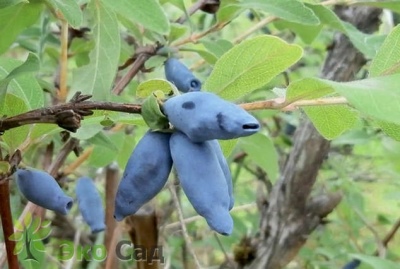
- Authors: M.N. Plekhanov, A.V. Kondrikova (Vavilov All-Russian Institute of Plant Genetic Resources)
- Year of approval: 2002
- Growth type: medium-sized
- Description of the bush: medium spreading
- Escapes: thick, straight, light green, pubescent
- Leaves: large, green, elongated-oval
- Crown: flat-round, medium thickened
- Fruit size: large
- Fruit weight, g: 1,04
- Fruit shape: large, cylindrical, with a ridge at the top
Along with numerous fruit and berry bushes, summer residents plant edible honeysuckle on their backyard plots, which now performs not only a decorative function, but also produces healthy and tasty fruits. One of the most popular species is Pushkinskaya honeysuckle.
Breeding history
Pushkinskaya is a variety that appeared on the basis of the V.I. N.I. Vavilov in 2001. The authorship belongs to the famous scientists M.N. Plekhanova and A.V. Kondrikova. The berry crop appeared in the register of approved crops in 2002. Honeysuckle can grow in any region, be it Central or Far Eastern.
Description of the variety
An early ripe variety of honeysuckle is a medium-sized bush that grows up to 1.5 meters in height under favorable conditions. The shrub is characterized by a flat-round shape of the crown with moderate spreading of branches and an average thickening of bright green, elongated-oval leaves. Another feature of the shrub is thick, upright shoots with a pronounced edge.
The flowering culture begins in the first days of May. During this period, the crown transforms, becoming covered with large pinkish-light flowers, which attract all insects with their aroma.
Fruit characteristics
Pushkinskaya berries represent a category of large-fruited varieties. On average, the fruit weighs 1.04 grams, and the length reaches 2 cm. The shape of the berries is classic - cylindrical with a pronounced roller at the top. Ripe honeysuckle is evenly covered with a bluish-blue tone, which is chaotically diluted with a rich waxy bloom. Sometimes the color of the berries is dark blue. The peel of the berries is rather thin, but firm, with a smooth surface. The berries keep on short and thickened stalks, however, when ripe, they crumble (up to 20%).
The purpose of the fruit is universal, so honeysuckle is eaten fresh, processed into jams, compotes and fruit drinks are prepared, and also frozen and dried. Long distance transport is not recommended for harvested berries. It should also be borne in mind that the keeping quality of fruits is weak - up to 3-4 days in the refrigerator and 1 day at room temperature.
Taste qualities
Honeysuckle is famous for its excellent taste. The pulp of the berries is very tender, fleshy, juicy, with a pronounced aroma. Harmonious taste - sweet and sour, without bitterness and cloying. A huge advantage of the variety is the valuable composition of the pulp, which contains less than 9% of sugars, more than 2% of acids, a complex of vitamins - A, C, B, as well as trace elements, tannins.
Ripening and fruiting
The variety is early maturing. The shrub gives the first harvest in the 3-4th year after planting. The berries are ripening almost at the same time and quickly crumble, so it is recommended to harvest the crop twice a day. You can taste honeysuckle in the third decade of June. Active ripening of fruits on the bush begins at the end of June.
Yield
The yield of the variety is excellent. Having provided the plant with good care, up to 3 kg of useful berries can be removed from 1 bush.Commercial farmers get an average of 53.3 quintals of berries per hectare of plantation.

Self-fertility and the need for pollinators
Honeysuckle Pushkinskaya, like most edible varieties, is not self-fertile. Therefore, it needs additional cross-pollination. For this, donor varieties planted nearby on the site are ideal. The honeysuckle varieties Blue Bird, Novinka, Berel, Slastena and Cubic Zirconia will become effective pollinating shrubs. In addition, bumblebees, bees, wasps and butterflies are good pollinators.
Growing and care
It is recommended to plant Pushkin's honeysuckle in autumn (in September or October). For this, a two-year-old seedling is bought. It is important not only to find the right place, but also to keep the distance between plantings - 150-200 cm.
Cultural agrotechnology consists of basic activities: regular watering, especially in the first year after planting, fertilizing from 3 years old, crown formation over several years, sanitary pruning of dry branches, weeding and loosening of the soil. After 7-8 years of growth, you can carry out anti-aging pruning of branches.


Disease and pest resistance
Due to its high immunity, the variety is not susceptible to fungal and bacterial infections. Along with this, berry crops are often attacked by insect pests - scale insects, aphids, and ticks.

Winter hardiness and the need for shelter
The culture has a high frost resistance, therefore, the bushes do not need additional shelter. Honeysuckle easily survives temperature drops down to -40 degrees. The only thing you need to know is that in winter the bushes are attacked by birds, so you need a shelter with synthetic textiles or netting.
Location and soil requirements
Honeysuckle is planted in a sunny and not swampy area, where the soil is loose, fertile, breathable, with low acidity, for example, loam or neutral soils.
































































